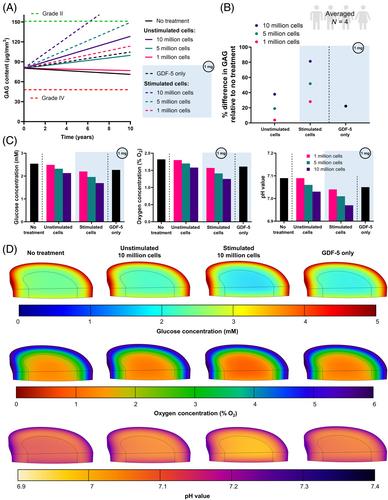While growth factors have the potential to halt degeneration and decrease inflammation in animal models, the literature investigating the effect of dosage on human cells is lacking. Moreover, despite the completion of clinical trials using growth differentiation factor-5 (GDF-5), no results have been publicly released.
The overall objective was to quantitatively assess the effect of three clinically relevant concentrations of GDF-5 (0.25, 1, and 2 mg) as a therapeutic for disc regeneration.
Firstly, this work experimentally determined the effects of GDF-5 concentration on the metabolic and matrix synthesis rates of human nucleus pulposus (NP) cells. Secondly, in silico modeling was employed to predict the subsequent regenerative effect of different GDF-5 treatments (± cells).
This study suggests a trend of increased matrix synthesis with 0.25 and 1 mg of GDF-5. However, 2 mg of GDF-5 significantly upregulates oxygen consumption. Despite this, in silico models highlight the potential of growth factors in promoting matrix synthesis compared to cell-only treatments, without significantly perturbing the nutrient microenvironment.
This work elucidates the potential of GDF-5 on human NP cells. Although the results did not reveal statistical differences across all doses, the variability and response among donors is an interesting finding. It highlights the complexity of human response to biological treatments and reinforces the need for further human research and personalized approaches. Furthermore, this study raises a crucial question about whether these potential biologics are more regenerative in nature or better suited as prophylactic therapies for younger patient groups.
Biological agents exhibit unique characteristics and features, demanding tailored development strategies and individualized assessments rather than a one-size-fits-all approach. Therefore, the journey to realizing the full potential of biological therapies is long and costly. Nonetheless, it holds the promise of revolutionizing spinal healthcare and improving the quality of life for patients suffering from discogenic back pain.



